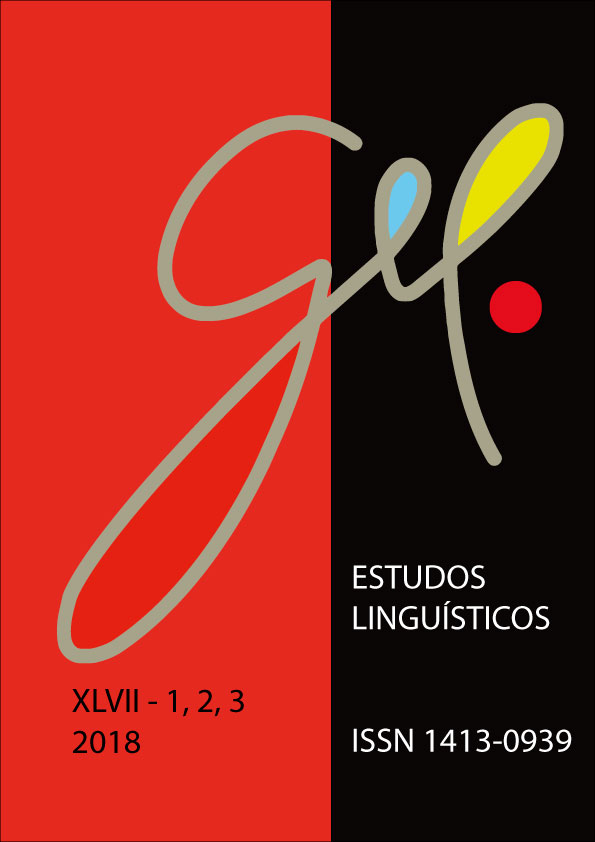Technologies and the intercultural communication in foreign language teaching/learning and teachers’ education
DOI:
https://doi.org/10.21165/el.v47i2.2054Keywords:
foreign languages, teachers’ development, telecollaborationAbstract
New contexts and perspectives have become gigantic in the educational scenery due to the development of digital technological tools. The access to people constitutes an important dimension in reconfiguration pedagogical practices, curriculum of courses and contexts of teachers’ development. In this scenery, the project Teletandem Brasil (TELLES, 2006) has opened doors for intercultural communication and singular experiences for Portuguese learners from foreign universities and foreign language learners from UNESP. Considering the contexts of telecollaboration for the promotion of changes regarding processes of languages teaching and learning, the goal of this article is to outline (a) a historical overview of the implementation of Teletandem, (b) to present the theoretical base and principles of Teletandem, (c) to present research perspectives in the field of telecollaboration.Downloads
References
ABRAHÃO, M. H. V. A formação inicial e continuada do professor no Teletandem Brasil: Línguas estrangeiras para todos. Trabalho apresentado na Conferencia Internacional de Educacion a Distancia – Instituto Tecnologico de Monterrey, Mexico, 2007.
BRAMMERTS, H.; CALVERT, M. Learning by communicating in tandem. In: LEWIS, T.; WALKER, L. (Eds.). Autonomous Language Learning In-Tandem. Sheffield, UK: Academy Electronic Publications, 2003. p. 45-60.
CAVALARI, S. M. S.; ARANHA, A. Teletandem: integrating e-learning into the foreign language classroom. Acta Scientiarum: Language and Culture, Maringá, v. 38, n. 4, p. 327-336, 2016.
CANDLIN, C.; HADFIELD, J. Prefácio. In: DUDENEY, G.; HOCKLY, N.; PEGRUM, M. Letramentos digitais. Tradução de M. Marcionilo. São Paulo: Parábola Editorial, 2016.
DOUGHTY, C.; WILLIAMS, J. (Ed.). Focus on form in classroom second language acquisition. Cambridge: Cambridge University Press, 2004.
FAIRCLOUGH, N. Discurso e mudança social. Brasília: Editora Universidade de Brasília, 2001.
FUNO, L. B. A. Teletandem: um estudo sobre identidades culturais e sessões de mediação da aprendizagem. 2015. 190 f. Tese (Doutorado em Estudos Linguísticos) – Instituto de Biociências, Letras e Ciências Exatas, Universidade Estadual Paulista “Júlio de Mesquita Filho”, São José do Rio Preto, 2015.
GARCIA, D. N. M. O feedback entre diferentes culturas: a perspectiva do exterior. Revista da Anpoll, v. 1, n. 42, p. 96-109, 2017.
GARCIA, D. N. M. Teletandem: Acordos e negociações entre os pares. 2010. 290 f. Tese (Doutorado em Estudos Linguísticos) – Instituto de Biociências, Letras e Ciências Exatas, Universidade Estadual Paulista “Júlio de Mesquita Filho”, São José do Rio Preto, 2010.
GARCIA, D. N. M. O professor e a prática telecolaborativa no teletandem. The Especialist (PUCSP), v. 32, n. 1, p. 81-108, 2011.
LEWIS, M. The lexical approach: The state of ELT and the way forward. Hove, United Kingdom: Language Teaching Publications, 1993.
LITTLE, D. et al. Evaluating tandem language learning by e-mail: report on a bilateral project. CLCS Occasional Paper, Trinity College Dublin, n. 55, p. 1-54, 1999.
SALOMÃO, A. C. B. Gerenciamento e estratégias pedagógicas na mediação dos pares no teletandem e seus reflexos para as práticas pedagógicas dos interagentes. 2008. 317 f. Dissertação (Mestrado em Estudos Linguísticos) – Instituto de Biociências, Letras e Ciências Exatas, Universidade Estadual Paulista “Júlio de Mesquita Filho”, São José do Rio Preto, 2008.
SCHWIENHORST, K. Matching pedagogy and technology – Tandem learning and learner autonomy in online virtual language environments. In: SOETAERT, R.; DE MAN, E.; VAN BELLE, E. (Eds.). Language Teaching On-Line. Ghent: University of Ghent, 1998, p. 115-127.
SOUZA, M. G. Teletandem e mal-entendidos na comunicação intercultural online em língua estrangeira. 2016. 170 f. Tese (Doutorado em Estudos Linguísticos) – Instituto de Biociências, Letras e Ciências Exatas, Universidade Estadual Paulista “Júlio de Mesquita Filho”, São José do Rio Preto, 2016.
TELLES, J. A. TELETANDEM: Transculturalidade na comunicação online em línguas estrangeiras por webcam. Teletandem News, ano V, n. 1, p. 2-3, jan./abr. 2011.
VASSALLO, M. L.; TELLES, J. A. Aprendendo línguas estrangeiras in-tandem: histórias de identidades. Revista Brasileira de Linguística Aplicada, v. 8, n. 2, p. 341-381, 2008.
VASSALLO, M. L.; TELLES, J. A. Foreign language learning in-tandem: Theoretical principles and research perspectives. The ESPecialist, São Paulo: Educ, v. 27, n. 1, p. 83-118, 2006.
WELSCH, W. Transculturality: the puzzling form of cultures today. In: FEATHERSTONE, M.; LASH, S. Spaces of Culture: City, Nation, World. London: Sage, 1999. p. 194-213.
ZAKIR, M. A. Cultura e(m) telecolaboração: uma análise de parcerias de teletandem institucional. 2015. 232 f. Tese (Doutorado em Estudos Linguísticos) – Instituto de Biociências, Letras e Ciências Exatas, Universidade Estadual Paulista “Júlio de Mesquita Filho”, São José do Rio Preto, 2015.



